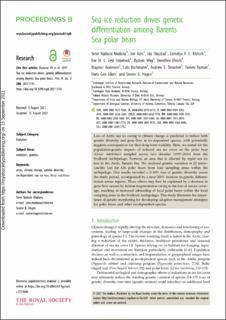| dc.contributor.author | Maduna, Simo | |
| dc.contributor.author | Aars, Jon | |
| dc.contributor.author | Fløystad, Ida | |
| dc.contributor.author | Klutsch, Cornelya | |
| dc.contributor.author | Fiskebeck, Eve Marie Louise Zeyl | |
| dc.contributor.author | Wiig, Øystein | |
| dc.contributor.author | Ehrich, Dorothee | |
| dc.contributor.author | Andersen, Magnus | |
| dc.contributor.author | Bachmann, Lutz | |
| dc.contributor.author | Derocher, Andrew E. | |
| dc.contributor.author | Nyman, Tommi | |
| dc.contributor.author | Eiken, Hans Geir | |
| dc.contributor.author | Hagen, Snorre | |
| dc.date.accessioned | 2021-11-03T15:18:08Z | |
| dc.date.available | 2021-11-03T15:18:08Z | |
| dc.date.created | 2021-09-09T12:34:47Z | |
| dc.date.issued | 2021-09-08 | |
| dc.identifier.citation | Proceedings of the Royal Society of London. Biological Sciences. 2021, 288 (1958), 1-10. | en_US |
| dc.identifier.issn | 0962-8452 | |
| dc.identifier.uri | https://hdl.handle.net/11250/2827686 | |
| dc.description.abstract | Loss of Arctic sea ice owing to climate change is predicted to reduce both genetic diversity and gene flow in ice-dependent species, with potentially negative consequences for their long-term viability. Here, we tested for the population-genetic impacts of reduced sea ice cover on the polar bear (Ursus maritimus) sampled across two decades (1995–2016) from the Svalbard Archipelago, Norway, an area that is affected by rapid sea ice loss in the Arctic Barents Sea. We analysed genetic variation at 22 microsatellite loci for 626 polar bears from four sampling areas within the archipelago. Our results revealed a 3–10% loss of genetic diversity across the study period, accompanied by a near 200% increase in genetic differentiation across regions. These effects may best be explained by a decrease in gene flow caused by habitat fragmentation owing to the loss of sea ice coverage, resulting in increased inbreeding of local polar bears within the focal sampling areas in the Svalbard Archipelago. This study illustrates the importance of genetic monitoring for developing adaptive management strategies for polar bears and other ice-dependent species. | en_US |
| dc.language.iso | eng | en_US |
| dc.publisher | Royal Society | en_US |
| dc.rights | Navngivelse 4.0 Internasjonal | * |
| dc.rights.uri | http://creativecommons.org/licenses/by/4.0/deed.no | * |
| dc.subject | Genetisk diversitet | en_US |
| dc.subject | Genetic diversity | en_US |
| dc.subject | Klimarett | en_US |
| dc.subject | Climate change | en_US |
| dc.subject | Bestandsovervåkning | en_US |
| dc.subject | Population Monitoring | en_US |
| dc.subject | Arktis | en_US |
| dc.subject | Arctic | en_US |
| dc.title | Sea ice reduction drives genetic differentiation among Barents Sea polar bears | en_US |
| dc.type | Peer reviewed | en_US |
| dc.type | Journal article | en_US |
| dc.description.version | publishedVersion | en_US |
| dc.rights.holder | © 2021 The Authors | en_US |
| dc.subject.nsi | VDP::Genetikk og genomikk: 474 | en_US |
| dc.subject.nsi | VDP::Genetics and genomics: 474 | en_US |
| dc.subject.nsi | VDP::Genetikk og genomikk: 474 | en_US |
| dc.subject.nsi | VDP::Genetics and genomics: 474 | en_US |
| dc.source.pagenumber | 1-10 | en_US |
| dc.source.volume | 288 | en_US |
| dc.source.journal | Proceedings of the Royal Society of London. Biological Sciences | en_US |
| dc.source.issue | 1958 | en_US |
| dc.identifier.doi | 10.1098/rspb.2021.1741 | |
| dc.identifier.cristin | 1932816 | |
| cristin.ispublished | true | |
| cristin.fulltext | original | |
| cristin.qualitycode | 2 | |

